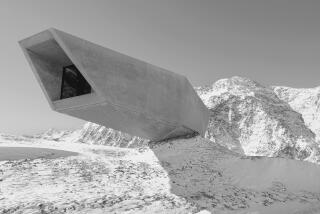A History of Architecture : by Spiro Kostof (Oxford: $45; 788 pp.)
At last, an exception to the tendency of most architectural histories to focus on a boring succession of notable buildings, seemingly marching through time and space as isolated monuments, their structure and style examined, though with little else to explain them as particular products of particular cultures created to meet specific human needs.
Spiro Kostof does not bore. Before examining even one structure in his sweeping survey of the man-made environment, from huts built thousands of years ago to current post-modern pastiches, the UC Berkeley professor makes it quite clear that he considers architecture a social act, “nothing more and nothing less than the gift of making places for some human purpose.”
If this weren’t radical enough in this day and age when select architects in defense of their failed buildings describe them as art objects (and are applauded for it), Kostof declares that “no building is an isolated object, sufficient unto itself,” but exists within a context. And he adds that not just monuments, but “all past buildings, regardless of size, status, or consequence, deserve to be studied.”
With this refreshingly pluralistic view, Kostof leads a tour through the succession of architectural eras and their principal landmarks, including classical Greece, Moorish Spain, Gothic France, Islamic Istanbul, Romanesque Florence, Byzantine Venice, Rococo Rome, Industrial England, Modern Germany and Romantic America. The sweep is impressive, if not at times too sweeping. Kostof can be flip, much like a tour guide striding through an Italian piazza trying to be both informative and entertaining, no easy task when embracing all of history over the din of motorbikes.
Nevertheless, Kostof succeeds, at least for most of the tour, particularly through Europe in the 17th, 18th and 19th centuries. Helping immensely are 950 illustrations, including 150 drawings by architect Richard Tobias. Styles and structures are noted, as well as the shifting notions of government, religion, commerce and life styles creating the needs and forms of the buildings and their settings, the emerging cities.
A fine urban consciousness is at work here, recognizing that the principle theater in which the drama of architecture occurs is indeed the city, and therefore to understand architecture, one must understand planning and urban design, as well as their guiding politics and philosophies.
The closer Kostof moves his narrative to the present, unfortunately the weaker and more general the survey becomes. Though the built environment continues to expand exponentially, with what has been created in concrete and steel in this century alone almost equal to the sum of construction of all previous centuries, Kostof races through it as if he were waiting for the bell to end the class. It rings a bit too soon, almost, it seems, with Kostof in mid-sentence as he strains to explain the current conflicts in architecture.
Also detected are a few errors, such as the description of Stuyvesant Town and Peter Cooper Village in New York as high-rise public housing, and the explanation that the Coca-Cola bottling plant in Los Angeles was designed in the style of a sleek ocean liner because it lent the company an image of purity. Actually, the housing was built by an insurance company and is privately operated, and the nautical design of the plant was prompted simply by deference to the company’s president, a weekend sailor.
Still, the effort is quite impressive. Kostof has produced what in time should become a classic among architectural textbooks, hopefully prompting students and others with an interest in design to search beyond stylish facades to the society surrounding them for the answers to why our buildings and cities look the way they do.
More to Read
The biggest entertainment stories
Get our big stories about Hollywood, film, television, music, arts, culture and more right in your inbox as soon as they publish.
You may occasionally receive promotional content from the Los Angeles Times.










